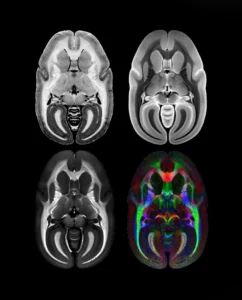Humans are part of the primate world, with a total of 200 species – and in the process, Monkeys, Lemurs, and Apes stand to be our cousins. All evolved from the same ancestors over the last 60 million years. It is the basic genes that stand to be similar. Common Marmosets are also part of the same family, small enough to fit in the palm of humans.
However, in contrast to their physical size, these monkeys have a brain with cells similar to that of humans. Thus helping the researchers unlock important insights into psychiatric and neurodegenerative conditions – like Parkinson’s and Alzheimer’s diseases, motor neuron disease, and autism spectrum disorders. Common Marmosets are a flexible match, helping scientists unravel the lesser-known facts about the human brain.
Why Are Common Marmosets The Best Match?
Researchers for the longest have been experimenting on rats, guinea pigs, and various forms of monkeys to understand the potential effects of various drugs before applying them to humans. However, among monkeys, the Common Marmosets are the closest to the human tribe, offering immense advantages over other potential study models.
Continue with your reading task to find out a detailed overview of the question, “Why are Common Marmosets the best match?”
Smaller In Size
In comparison to Baboons and Macaques, Marmosets are smaller in size. Thus it becomes convenient for the researchers to keep them inside the laboratory and continue suitable observations from time to time. Also, these monkeys are known for their rapid growth and early sexual maturation, helping researchers plan suitable breeding programs.
Possesses Similar Social Behaviors As That Of The Humans
Moreover, the Marmoset tribe do showcase a similar sexual orientation as that of the humans. These animals have complex social behavior mimicking humans’ whereabouts, sophisticated communication patterns, and intricate family structures.
Genetical Accuracy
Modern scientists are working towards developing advanced genome editing tools, looking for adequate possibilities to eradicate multiple genetically problematic conditions in the future. And in the process, they find the Common Marmosets offering great help with precise experimentation tasks. All thanks to the genetic similarity between these monkeys and humans. Researchers can continue with their work, creating precise and targeted modifications in the gene of these monkeys to come up with relevant solutions to human problems. The monkeys mirror specific conditions only found in humans, which are otherwise impossible in conventional rodent models.
Common Marmosets And Critical Genetic-Modification Techniques
According to Hideyuki Okano, a neuroscientist – “There are no other genetically modified animal models that so precisely mimic the human brain disorders.” Researchers conveyed that the Common Marmosets exhibit symptoms resembling those observed in humans with Parkinson’s.

In 2009, a research team by Okano, Erika Sasaki, and their colleagues made headlines by developing transgenic Marmosets, the first of their kind. The scientists made a genetic grafting in the genes of these monkeys – combining them with jellyfish genes. As a result, the animals’ cells started to grow under a special light. Later, these monkeys passed down the genes to their offspring. Thus proving how stable genetic manipulations are possible, paving the way to eradicating certain human disorders.
Also, in 2017, a research group from Tokyo went forward, creating another Marmoset model. Here they introduced random defective human genes into the monkey’s genome. Owing to the genetic similarity between the humans and the Common Marmosets, the research team adhered to such a technique, analyzing and finalizing drugs they would use on humans to develop a steady cure.
Common Marmosets And Pharmaceutical Implications
So far, most experimental drugs for human brain diseases have failed to launch since there were not enough research models to experiment with. However, the Common Marmosets show a new ray of hope to pharmaceutical companies, helping the researchers conduct pre-clinical laboratory tests.
According to researchers, the Marmosets are more accurate in showcasing what it would be like to put the same drug into humans. And the researchers can continue with changes accordingly.
In the past and present, multiple research has been conducted on the Common Marmosets, and the teams are looking forward to many more.




